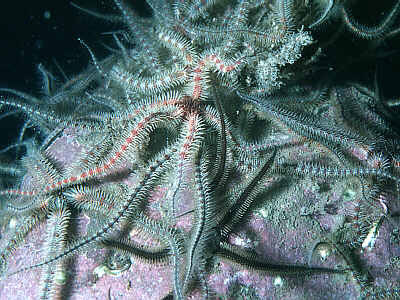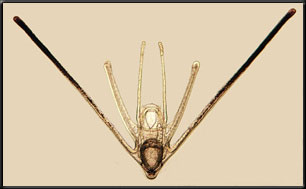 You can see that some of them are holding up their arms into the water. This is the typical
posture used for feeding by suspension feeding brittle stars.
You can see that some of them are holding up their arms into the water. This is the typical
posture used for feeding by suspension feeding brittle stars.
| MadSci Network: Zoology |
Hi Jeff,
I apologize for taking so long to answer your question, but I've been out of town and just returned the other day. Your question is very interesting, so let's talk about brittle stars!
Brittle stars feed in a variety of ways, although most of them are what we marine
biolgists call suspension feeders. Suspension feeders eat particles that are
suspended in the water column, but they don't actively pump water through any kind of
filter. Brittle stars do this by holding up their arms. Tube feet on the arms grab particles,
then transport them to the mouth which is located on the underside of the central disc.
Here's a photo of some brittle stars:
 You can see that some of them are holding up their arms into the water. This is the typical
posture used for feeding by suspension feeding brittle stars.
You can see that some of them are holding up their arms into the water. This is the typical
posture used for feeding by suspension feeding brittle stars.
Some brittle stars are deposit feeders, which means they feed on organic materials that are usually collected from the bottom. They do this by sweeping their arms over the bottom. Sticky mucus on the arms traps the organic matter, and the tube feet are again used to convey the food to the mouth.
There are some predaceous brittle stars, too. These capture prey by wrapping an arm around a small animal, then curling the arm under to bring the food to the mouth.
You also asked for other interesting facts about brittle stars. I've compiled a list of some of the reasons that I think brittle stars are cool:
1. Brittle stars have an incomplete gut, also called a 2-way gut. This means their
digestive tract has only one opening, which serves as both a mouth and an anus. Think
about what it would be like to have an incomplete gut. Hmm. . .
2. Brittle stars can regenerate lost arms, or parts of arms. In fact, they are called "brittle
stars" because they will readily cast off an arm to get away from predators; they really ARE
brittle!
3. They go through a larval stage that doesn't look anything like a brittle star. This larva is
called an ophiopluteus:
 Would you have guessed that this animal would turn into a brittle star when it grows up?
Would you have guessed that this animal would turn into a brittle star when it grows up?
Thanks for the question. I hope this answers it!
Allison J. Gong
Mad Scientist
Reference: Brusca and Brusca, 2003. The Invertebrates. Sinauer Associates, Inc.
Try the links in the MadSci Library for more information on Zoology.